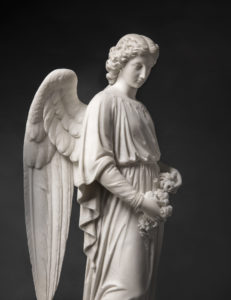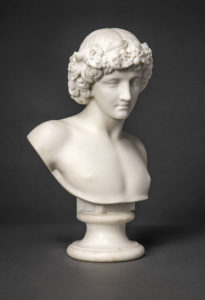 The Heckscher Museum of Art has acquired two exceptional, rare marble sculptures by American artist Emma Stebbins (1815-1882): Lotus Eater, 1863, and Sandalphon, 1866. A portrait of Stebbins painted around 1839 by American artist Henry Inman (1801-1846) also joined the collection.
The Heckscher Museum of Art has acquired two exceptional, rare marble sculptures by American artist Emma Stebbins (1815-1882): Lotus Eater, 1863, and Sandalphon, 1866. A portrait of Stebbins painted around 1839 by American artist Henry Inman (1801-1846) also joined the collection.
“Emma Stebbins’ work has been essential to The Heckscher Museum’s collection since the 1920s. Charles August Heckscher, an uncle of the Museum’s founder, commissioned Stebbins’s Commerce and Industry in 1859,” said Heather Arnet, Executive Director and CEO. “With the addition of Lotus Eater and Sandalphon, The Heckscher Museum is proud to now steward the largest public collection of Stebbins’ sculptures.”
Lotus Eater, Sandalphon, and the portrait of Stebbins have been in a private collection and likely have not been on public view in more than 100 years. Each sculpture required extensive cleaning of the discolored marble surfaces and careful repairs. The portrait has grime and a dull varnish layer obscuring the pigments and the canvas requires stabilization. The professional conservation of these works is funded through 2023 and 2024 conservation grants from the Greater Hudson Heritage Network (GHHN)/New York State Council on the Arts (NYSCA) and the Robert David Lion Gardiner Foundation.
The Museum’s Chief Curator, Dr. Karli Wurzelbacher, notes, “These conservation efforts are crucial to ensuring that Emma Stebbins’ artistic legacy is celebrated, protected and shared with future generations.”
Stebbins is the sculptor of Angel of the Waters (1873) which sits atop the Bethesda Fountain in New York’s Central Park. Angel of the Waters represents the first time that a female artist received a public art commission in New York City. This monumental work has since become the symbol of Central Park and an enduring icon for the city. 
Despite her remarkable transatlantic career, many people are not aware of the full scope and impact of Stebbins’ career and achievements. She was born in New York City to a prominent banking family and received her early artistic training in drawing and painting. In 1857, Stebbins moved to Rome, the center of the neoclassical world, and became a successful sculptor. Her work encompasses unprecedented neoclassical imagery of nineteenth-century laborers, inventive and incisive depictions of literary and biblical subjects, and moving portrait busts of friends and family members, as well as monumental public sculptures in New York and Boston.
In Rome, Stebbins met the celebrated American actor Charlotte Cushman (1816-1876). Cushman was a “superstar” of the theater and her performances garnered acclaim throughout Europe and America. Stebbins and Cushman viewed their relationship as a marriage, and they lived together until Cushman’s death.
Lotus Eater and Sandalphon were conserved by Tatti Art Conservation in 2023. Henry Inman’s portrait of Stebbins will be conserved by ArtCare Conservation this year.
The conservation of these works was supported through the NYSCA/GHHN Conservation Treatment Grant Program administered by Greater Hudson Heritage Network. The program is made possible by the New York State Council on the Arts with support of the Office of the Governor and the New York Legislature. Additional support is provided by the Robert David Lion Gardiner Foundation.


